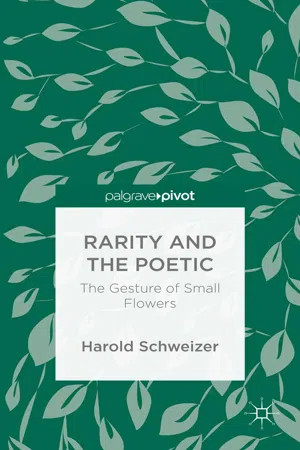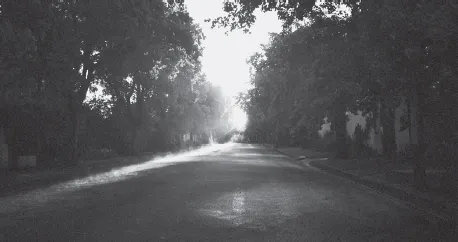
This is a test
- English
- ePUB (mobile friendly)
- Available on iOS & Android
eBook - ePub
Book details
Book preview
Table of contents
Citations
About This Book
Rarity is a quality by which things flowers, leaves, light, sound fleetingly appear and disappear, leaving in their wake a resonance of something we just thought we had glimpsed. Each of the nine chapters in this book pursues such intimations of rarity in poetic ideas, images, and silences.
Frequently asked questions
At the moment all of our mobile-responsive ePub books are available to download via the app. Most of our PDFs are also available to download and we're working on making the final remaining ones downloadable now. Learn more here.
Both plans give you full access to the library and all of Perlego’s features. The only differences are the price and subscription period: With the annual plan you’ll save around 30% compared to 12 months on the monthly plan.
We are an online textbook subscription service, where you can get access to an entire online library for less than the price of a single book per month. With over 1 million books across 1000+ topics, we’ve got you covered! Learn more here.
Look out for the read-aloud symbol on your next book to see if you can listen to it. The read-aloud tool reads text aloud for you, highlighting the text as it is being read. You can pause it, speed it up and slow it down. Learn more here.
Yes, you can access Rarity and the Poetic by Harold Schweizer in PDF and/or ePUB format, as well as other popular books in Literature & European Literary Criticism. We have over one million books available in our catalogue for you to explore.
Information
1
The Rarity of Shade
Abstract: Shade is a rarity of light. The amorphous qualities of shade are not to be confused with the definable contours of shadow. Not only is shade a subversion of what Maurice Blanchot has called “the optical imperative” of the western tradition, it is also a suspension of the Platonic binaries that define knowledge and ignorance. In the arc between these polarities, shade transforms to tone, and knowledge fades to intimation. If we can know rarity, we know it as we know shade.
Schweizer, Harold. Rarity and the Poetic: The Gesture of Small Flowers. Basingstoke: Palgrave Macmillan, 2016. DOI: 10.1057/9781137589293.0004.
I confess to not understanding well your “error.” There would be two kinds: one being the shadow of the true; the other – but this other, I wonder how you can speak of it.
Maurice Blanchot1
Let us speak of it as shade. The advantage of speaking of shade as a trope for “not understanding” is that shade bears none of the liabilities of Plato’s allegations of shadow’s unreality. While, according to Plato, shadow is simply a lie, shade does not purport falsely to represent a thing. Shade is not “the shadow of the true.” It cannot be reduced to the mimetic, two-dimensional shape of a shadow. Although shade is always caused by the shadow of an object, it is merely the rarity of light that we mean when we speak of shade.
Shade is a tone. Tone is a shade. We use the tropes of shade and tone when we apply them to those qualities of language by which language does not merely designate meanings, does not only refer to things, does not function as shadow. For words perform their signifying not only as shadows of things. In their more elusive, rarefied signification, they convey resonance, timbre, silence, intimation, tone – such “meanings” that might be implied in the gesture of flowers as they unfold “in an arc between the material and the immaterial.”2 For what a tone is a tone of we don’t know, but we know we have heard it and thereby know something more deeply, though the verb “know,” strictly speaking, does not apply. I wonder how one can speak of it.
* * *
Although caused by the shadow of a tree’s foliage, for example, shade does not seem thereby wholly determined or defined; shade is quality, affect, experience, whereas shadow is space, outline, silhouette. Shadow has, as it were, some conceptual density, whereas shade, by comparison, has rarity. Shade is not defined by the outlines or patterns of shadows on the ground but by a darkened, cool stillness of light. Thus shade is often used in figurative senses to denote a range of sentiments along the axis of the material to the immaterial, from joyful intimations of peace and shelter to the dread of death. Nor are the forebodings, pleasures or tranquility that shade evokes determinable states: they are not shadows but shades of feeling – of calm, of cool, of rest, of peace, but also of fear and dread. If we consult the dictionary, the multiple meanings of the word shade soon wander – from the initial misconception of shade as synonymous with shadow – into tropes such as twilight, dusk, night, death, foreboding, a variation, a ghost, a shelter, a retired spot, a shutter, “an ill defined patch of darker color on the wing of a moth.”3 The rarity of shade is not least in the instability of its meanings.
In his book Seeing Dark Things: A Philosophy of Shadows – there are some books on shadow, none on shade – Roy Sorensen writes about “the intangibility of shadows” and admits that although he can “feel that there was shadow,” he could not feel the shadow itself, only the objects therein.4 Shade, I suggest, is the word that designates this feeling that there is shadow, a feeling firstly of air, then of a diminished light, then of all the intangible, evanescent realities that air and light signify and convey as they extend themselves into our interior where they may darkly transform to existential intuitions of time and of ourselves: dusk, night, death, foreboding. But shade also has more cheerful effects, physical and mental, on those who find themselves in repose, in rest, in delay, in waiting, beautifully exemplified in Andrew Marvell’s “green thought in a green shade,”5 where shade – as in Kant’s philosophy of the beautiful – denotes the coalescence of inner and outer worlds. The beautiful has considerable rarity.
There can be no shade that is not also a location and time, as in the particular time and location always crucial for example in Impressionist paintings. Shade thus cannot be sustained; it moves, fades, lightens, darkens. Perhaps a different time passes in the diminished light of shade. Objects in shade seem to endure differently, without impatience, as if they were pausing, as if something delightfully – or ominously – delayed them.
One has to move oneself into the right measure of light; one needs to retreat from the glare of light in order to see, and yet I do not see well in shade, where outlines dissolve and merge into each other. Shade calls into question my seeing and the distance that seeing implies.
Shade, I propose, is what poetic language conveys. It “descends into the twilight of sonorities,”6 as Stéphane Mallarmé puts it. “Here what reveals itself,” writes Maurice Blanchot, “does not give itself up to sight, just as it does not take refuge in simple invisibility.”7 And later on, Blanchot claims very similarly: “the unknown ... does not belong to light, but rather to a region ‘foreign’ to the disclosure that is accomplished in and through light.”8 The rarity of shade is foreign to disclosure. It cannot be grasped.

FIGURE 1.1 Source: www.unsplash.com
* * *
An early poem of Wallace Stevens ends with the lines, “I never knew / That fluttering things have so distinct a shade.”9 Distinct in this shade are the transience and fragility of fluttering things. Transience, fragility, fluttering are exemplary qualities of rarity. Things flutter – we flutter too – because they have little solidity in time, no more solidity than shade. A much later poem, one of Stevens’s most important, “An Ordinary Evening in New Haven,” seems to confirm this notion of fluttering things; it ends with this brief meditation:
It is not in the premise that reality
Is a solid. It may be a shade that traverses
A dust, a force that traverses a shade.10
As if shade were a metaphor for a reality found rare, fluttering, insubstantial, like an ill defined patch of darker color on the wing of a moth. Since reality may be nothing more solid than a shade, since a shade might traverse nothing more solid than a dust – or a force, also not solid, that traverses a shade – Stevens assigns reality neither substance nor determinable cause, but only movement – and this in a language wholly qualified by speculation: reality “may be” a shade, a dust, a force traversing, a mere duration. All that is traversed by it is rendered itself a traversing, such as we are – transient, insubstantial, fluttering, dust, shade. Emerson, to whom Stevens is here indebted, calls such processes fluxional and vehicular: “the divine animal,” he writes in “The Poet,” “carries us through this world.”11
Words cast shadows, the shadows of the solid things to which they refer. We perform our functions, when conscious and public, in the realm of shadow. But the shadow of a word contains a shade of something of which it is not the premise that it is a solid. Shade as a trope for a poetic (un)knowing, for an intuitive s...
Table of contents
- Cover
- Title
- Introduction
- 1 The Rarity of Shade
- 2 The Rarity of the Gesture of Small Flowers
- 3 The Rarity of Attention
- 4 The Rarity of Dying
- 5 The Density of Suffering
- 6 The Rarity of Ones Own Death
- 7 The Rarity of Things
- 8 The Rarity of Accidents
- 9 The Rarity of the Beautiful
- Coda
- Bibliography
- Index